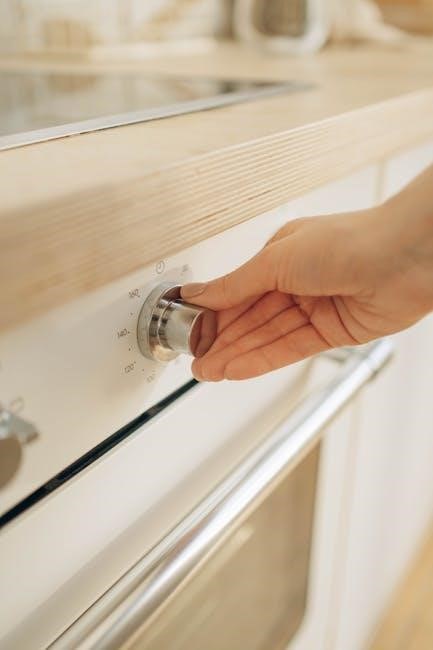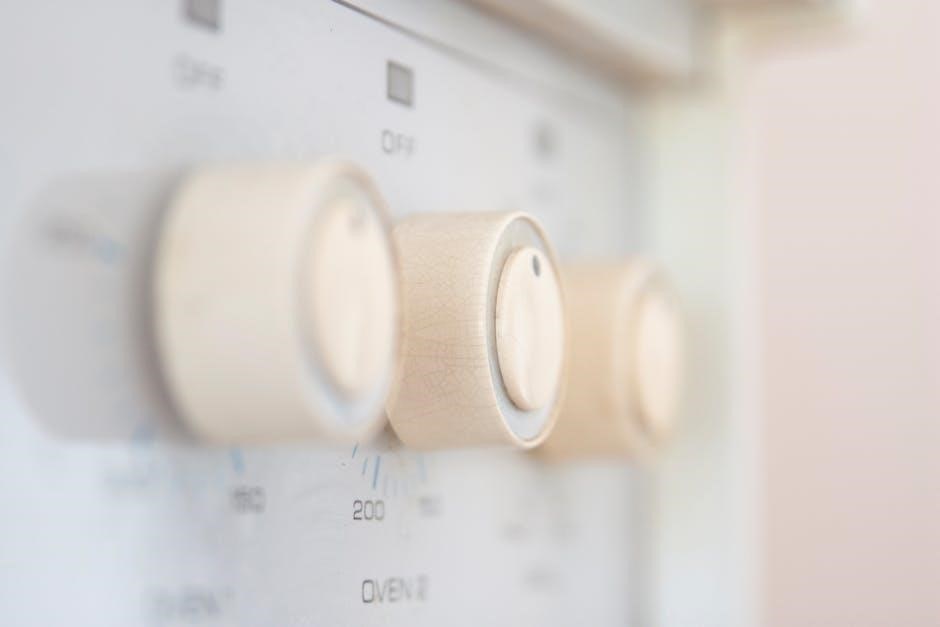Welcome to the Harman Pellet Stove XXV Manual, your comprehensive guide to installing, operating, and maintaining your stove for optimal performance and safety․ This manual ensures you understand all features, safety precautions, and maintenance requirements to enjoy reliable and efficient heating․
Overview of the Harman XXV Pellet Stove
The Harman XXV Pellet Stove is a freestanding, advanced heating solution designed for durability and efficiency․ Built with high-quality materials, it combines reliability with eco-friendly performance․ This stove is engineered to provide consistent heat while minimizing environmental impact․ Its sleek design and robust construction make it a versatile option for various spaces․ The XXV model is part of Harman’s anniversary series, celebrating 25 years of innovation in pellet stove technology․ It offers a user-friendly experience with intuitive controls and customizable settings, ensuring optimal comfort and energy efficiency for homeowners․
Importance of Reading the Manual
Reading the Harman Pellet Stove XXV Manual is crucial for safe and efficient operation․ It provides detailed instructions for installation, operation, and maintenance, ensuring optimal performance and longevity․ The manual highlights safety features, troubleshooting tips, and warranty information․ By understanding the guidelines, you can avoid potential hazards and maintain compliance with regulatory standards․ Proper usage, as outlined, maximizes energy efficiency and ensures reliable heating․ Familiarizing yourself with the manual is essential for enjoying years of trouble-free service from your Harman XXV Pellet Stove․
Key Features of the Harman XXV Pellet Stove
The Harman XXV Pellet Stove is a high-efficiency appliance designed for reliable and consistent heating․ It features advanced combustion technology, a smart fuel management system, and an eco-friendly design․ The stove is built with durable materials and offers customizable heat settings for optimal comfort․ Its user-friendly control panel simplifies operation, while the top vent options provide flexible installation choices․ With a focus on safety and energy efficiency, the Harman XXV is an excellent choice for homeowners seeking a sustainable and powerful heating solution․
- Advanced combustion technology for higher efficiency․
- Smart fuel management system for consistent performance․
- Top vent options for flexible installation․
- Eco-friendly design with minimal emissions․
- User-friendly control panel for easy operation․
Installation and Setup
Ensure proper installation by following clearance requirements, venting guidelines, and model-specific instructions for the Harman XXV Pellet Stove․ Refer to the manual for detailed setup procedures․
Pre-Installation Requirements
Before installing the Harman XXV Pellet Stove, ensure the space meets all safety and technical standards․ The room must have adequate ventilation and a minimum size of 150 square feet․ Maintain a minimum clearance of 36 inches from combustible materials․ Ensure the floor is protected with non-combustible material extending 18 inches beyond the stove․ Verify electrical connections meet local codes and the stove is placed on a level surface․ Check venting requirements and ensure compliance with local building codes and manufacturer guidelines for safe operation․
Step-by-Step Installation Guide
Begin by preparing the installation site, ensuring it meets clearance and venting requirements․ Place the stove on a heat-resistant surface, following the manufacturer’s guidelines․ Connect the venting system, starting from the stove to the termination point outside․ Secure all connections tightly to prevent leaks․ Install the chimney cap and ensure proper alignment․ Test the system by lighting a small fire to check for proper draft and ventilation․ Refer to the manual for specific diagrams and measurements to ensure accuracy․ Once installed, inspect all components for safety and functionality before regular use․
Clearance and Venting Requirements
Proper clearance and venting are essential for safe and efficient operation of the Harman XXV Pellet Stove․ Maintain minimum clearances of 36 inches from combustible materials on all sides and 48 inches above the stove․ Venting must use approved materials and follow local codes․ The stove requires a 3-inch diameter vent pipe for horizontal installations and 4-inch for vertical․ Ensure proper slope and avoid sharp bends to maintain draft efficiency․ Refer to the manual for specific clearance and venting specifications to prevent safety hazards and performance issues․
Top Vent Options and Instructions
The Harman XXV Pellet Stove offers flexible top venting options for convenient installation․ The stove supports both vertical and horizontal venting configurations, ensuring compatibility with various home layouts․ For vertical venting, use a stainless steel liner or approved chimney materials․ Horizontal venting requires a direct vent system, terminating outside the home․ Always follow the installation manual for specific clearance requirements and venting materials․ Proper venting ensures safe operation, efficiency, and compliance with safety standards․ Refer to the XXV-TC Pellet Stove ー Top Vent Options Instructions for detailed guidance and specifications․

Operating the Harman XXV Pellet Stove
Learn how to efficiently operate your Harman XXV Pellet Stove with this guide․ Understand ignition, control panel functions, and manual settings for optimal performance and heat control․
- Master ignition processes and daily operation․
- Adjust heat output and fuel flow settings․
- Explore manual operation capabilities for personalized use․
Starting the Stove for the First Time
Before starting your Harman XXV Pellet Stove, ensure all installation requirements are met, including proper venting and clearance․ Plug in the stove and allow it to power up․ Press and hold the ignition button until the control panel confirms the start sequence․ The stove will automatically feed pellets and ignite․ Once lit, monitor the flame and adjust settings as needed․ Refer to the control panel guide for temperature and feed rate adjustments․ Ensure the stove operates correctly before leaving it unattended․ If issues arise, consult the troubleshooting section or contact a professional․
Understanding the Control Panel
The control panel of the Harman XXV Pellet Stove is designed for intuitive operation․ It features a digital display and buttons for adjusting settings like heat output, fuel flow, and ignition․ Key controls include:
- Mode Selector: Switch between automatic and manual operation․
- Temperature Adjustment: Set your desired room temperature․
- Fuel Feed Rate: Adjust pellet flow for precise heat control․
- Ignition Button: Initiates the startup sequence․
- Diagnostic Lights: Indicate system status or potential issues․
This panel ensures easy management of the stove’s advanced features, optimizing efficiency and safety․
Manual Operation and Settings
The Harman XXV Pellet Stove offers a user-friendly interface for manual operation․ Using the control panel, you can adjust settings such as heat output, fuel flow, and ignition․ In manual mode, the stove allows you to override automatic functions, giving you precise control over combustion and heat distribution․ Always refer to the manual for specific instructions on adjusting these settings safely and effectively․ Regular monitoring of the burn pot and pellet flow ensures optimal performance and efficiency․ Adjustments should be made cautiously to avoid compromising safety or combustion quality․
Adjusting Heat Output and Fuel Flow
The Harman XXV Pellet Stove allows precise control over heat output and fuel flow, ensuring efficient operation․ Use the control panel to adjust settings, with options for manual or automatic modulation․ The stove features a smart fuel management system, optimizing pellet usage based on heat demand․ For higher heat, increase the fuel flow setting, while lower settings conserve fuel․ Always monitor output to maintain desired temperatures․ Regularly cleaning the burn pot and venting system ensures proper airflow and efficient combustion․ Adjustments should align with the stove’s eco-friendly design to maximize energy savings and performance․ Proper calibration enhances safety and efficiency․

Maintenance and Care
Regular cleaning and inspections ensure optimal performance․ Daily upkeep includes cleaning burn pots and ash pans, while seasonal maintenance involves checking venting systems and replacing worn parts․
Daily Cleaning and Upkeep
Regular maintenance is crucial for the efficiency and safety of your Harman XXV Pellet Stove․ Daily tasks include cleaning the burn pot, removing ashes, and wiping the glass․ Ensure the ash pan is emptied and inspected for damage․ Clean the stove’s exterior with a damp cloth to prevent dust buildup․ Check the venting system for blockages and ensure all connections are secure․ Weekly, inspect the gaskets and seals for wear․ Proper upkeep prevents malfunctions and ensures optimal performance․ Always refer to the manual for detailed cleaning instructions․
Seasonal Maintenance Tips
Regular seasonal maintenance ensures your Harman XXV Pellet Stove operates efficiently and safely․ Before the heating season, inspect and clean the venting system, replace the gasket if necessary, and ensure the burn pot and heat exchanger are free of debris․ After the season, clean the stove thoroughly, including the combustion chamber and glass․ Check for wear on the auger and igniter, and apply a rust inhibitor to metal parts during the off-season․ These steps maintain performance and extend the stove’s lifespan․ Always refer to the manual for detailed guidance․
Replacing Wear and Tear Parts
Regularly inspect and replace wear and tear parts to maintain your Harman XXV Pellet Stove’s performance․ Common replacements include gaskets, ignitors, and auger motors․ Always refer to your manual for specific part numbers and guidelines․ Clean or replace these components as needed to prevent damage․ For complex replacements, consider consulting a professional․ Ensure all parts are genuine Harman products for compatibility and safety․ Proper maintenance extends the stove’s lifespan and ensures efficient operation․ Keep spare parts on hand to avoid downtime during heating season․
troubleshooting Common Issues
Troubleshooting Common Issues
Identify and resolve common issues with your Harman XXV Pellet Stove to ensure optimal performance․ Issues like ignition failures or low heat output can often be traced to faulty igniters or blocked vents․ Check for proper pellet quality, as poor fuel can disrupt combustion․ If the stove shuts off unexpectedly, ensure the hopper is filled and the fuel flow is unrestricted․ For error codes, refer to the manual or contact customer support․ Regular cleaning and maintenance can prevent many issues, ensuring reliable and efficient operation․

Safety Guidelines
Always follow general safety precautions to prevent accidents․ Ensure proper fire safety measures and monitor carbon monoxide levels․ Familiarize yourself with emergency shutdown procedures for safe operation․
General Safety Precautions
Always follow these essential safety guidelines when operating the Harman Pellet Stove XXV․ Keep flammable materials like curtains, rugs, and furniture at least 3 feet away from the stove․ Ensure proper venting to avoid carbon monoxide buildup․ Never operate the stove without a proper venting system․ Avoid overloading the stove with fuel, as this can cause unsafe conditions․ Keep children and pets away from the stove while it is in operation․ Regularly inspect electrical components and connections to prevent hazards․ Never leave the stove unattended during operation, and always follow the manufacturer’s instructions for startup and shutdown procedures․ Annual professional inspections are recommended to ensure safe and efficient performance․
Fire Safety and Prevention
To ensure safe operation of your Harman Pellet Stove XXV, always follow fire safety guidelines․ Keep the area around the stove clear of flammable materials, such as curtains or furniture․ Never use improper fuels, as they can cause unpredictable fires․ Regularly inspect the venting system for damage or blockages, which can lead to hazardous conditions․ Monitor the stove’s operation, especially during the first use, and keep a fire extinguisher nearby․ Proper maintenance, as outlined in this manual, is crucial for preventing accidents and ensuring reliable performance․
- Always store pellets in a dry, well-ventilated area․
- Avoid overloading the hopper to prevent fuel spills․
- Never leave children or pets unattended near the stove․
By following these guidelines, you can enjoy a safe and efficient heating experience with your Harman XXV Pellet Stove․ Refer to the manual for detailed safety protocols․
Carbon Monoxide Safety
Carbon monoxide (CO) safety is critical when operating your Harman XXV Pellet Stove․ Proper installation, venting, and maintenance are essential to prevent CO buildup․ Ensure your stove is vented correctly, and annual inspections are performed by a qualified technician․ Install a CO detector in your home to alert you of dangerous levels․ Never operate the stove with a blocked vent or damaged components, as this can lead to CO leaks․ Follow all manufacturer guidelines to ensure safe operation and protect your household from potential hazards․ Failure to comply may result in serious health risks or void your warranty․
Emergency Shutdown Procedures
In case of an emergency, follow these steps to safely shut down your Harman XXV Pellet Stove:
Turn off the power supply immediately to stop the stove’s operation․
Close the fuel supply valve to prevent further pellet flow․
Allow the fire to burn out naturally—do not use water to extinguish it․
Open windows for ventilation to reduce carbon monoxide levels․
Contact a professional if the issue persists․ Always refer to your manual for detailed instructions․

Advanced Features and Efficiency
The Harman XXV Pellet Stove boasts cutting-edge technology, including advanced combustion systems and smart fuel management, ensuring maximum energy efficiency while minimizing environmental impact and operational costs․
Energy Efficiency and Savings
The Harman XXV Pellet Stove is designed with cutting-edge technology to maximize energy efficiency, reducing fuel consumption and lowering heating costs․ Its advanced combustion system ensures optimal fuel utilization, minimizing waste and emissions․ By efficiently converting pellet fuel into heat, the stove provides consistent warmth while maintaining eco-friendly performance․ This design not only saves you money on energy bills but also contributes to a sustainable environment․ Proper maintenance and operation, as outlined in this manual, will further enhance its efficiency and longevity․
Advanced Combustion Technology
The Harman XXV Pellet Stove features cutting-edge combustion technology designed for exceptional efficiency and performance․ This system ensures a clean, complete burn of pellets, minimizing emissions and maximizing heat output․ Advanced sensors and airflow controls optimize combustion, providing consistent and reliable operation․ The technology also reduces fuel consumption while maintaining high heat production, making it eco-friendly and cost-effective․ This innovative design enhances safety by monitoring and adjusting combustion parameters, ensuring a trouble-free experience․ With its advanced combustion system, the Harman XXV delivers superior performance and environmental benefits․
Smart Fuel Management System
The Smart Fuel Management System in the Harman XXV Pellet Stove optimizes fuel usage for maximum efficiency․ This advanced feature ensures precise control over pellet flow, adjusting heat output based on demand․ It monitors fuel levels and burn rates in real time, minimizing waste and maximizing energy output․ The system also allows for customizable settings to match your heating needs, ensuring consistent performance while reducing fuel consumption․ This intelligent design enhances overall efficiency, making the stove both eco-friendly and cost-effective for long-term savings․
Eco-Friendly Design and Benefits
The Harman XXV Pellet Stove is designed with eco-consciousness in mind, utilizing renewable pellet fuel for a sustainable heating solution․ Its advanced combustion technology minimizes emissions, aligning with EPA standards for environmental protection․ Constructed with energy-efficient materials, the stove reduces waste and promotes eco-friendly performance․ By using recycled materials in its build, it supports environmental conservation․ This design not only benefits the planet but also offers cost savings through lower energy consumption, making it a responsible choice for homeowners seeking a greener heating option․

Accessories and Compatible Parts
Explore recommended accessories like log kits and venting systems, along with replacement parts and compatibility options to enhance your Harman XXV Pellet Stove experience and ensure safety․
Recommended Accessories
For optimal performance and convenience, consider adding recommended accessories to your Harman Pellet Stove XXV․ Essential items include a high-quality pellet venting kit, designed to ensure safe and efficient venting․ A pellet fuel storage container is also crucial for keeping your fuel dry and readily available․ Additionally, a stove brush and cleaning tools will help maintain your stove’s efficiency․ For added comfort, a remote control or smart thermostat can enhance temperature regulation․ Always purchase accessories from authorized dealers to ensure compatibility and safety․ These items complement your stove’s functionality and longevity․
Replacement Parts and Availability
For the Harman Pellet Stove XXV, replacement parts are readily available through authorized dealers or directly from the manufacturer․ Ensure all parts are genuine to maintain performance and safety․ Common replacements include burn pots, heat exchangers, and ignition systems․ Refer to the manual for part numbers and compatibility․ Online retailers also offer a selection of replacement parts, but verify authenticity before purchase․ Regularly inspecting and replacing worn components ensures optimal efficiency and longevity of your stove․ Contact Harman customer support for assistance in locating specific parts or scheduling professional service․
Compatible Venting Systems
For the Harman Pellet Stove XXV, compatible venting systems are crucial for safe and efficient operation․ Use only approved venting components designed for pellet stoves, ensuring proper draft and ventilation․ Direct vent systems are recommended, but horizontal venting may also be used with specific kits․ Stainless steel or approved double-wall vent pipes are required to withstand high temperatures․ Always check local regulations and the manual for clearance requirements․ Proper venting ensures optimal performance, safety, and compliance with environmental standards․ Refer to the manual for detailed venting configurations and compatibility guidelines․
Upgrading and Customization Options
The Harman XXV Pellet Stove offers various upgrade and customization options to enhance performance and aesthetics․ Users can install advanced venting systems or decorative trim kits for a personalized look․ Additionally, smart technology integrations allow for remote control and monitoring․ For optimal efficiency, consider upgrading to compatible bypass kits or advanced fuel management systems․ Always ensure upgrades align with the stove’s specifications and local regulations․ Refer to the Harman XXV Manual for compatible parts and installation guidelines to maintain warranty and safety standards․
Regulatory Compliance and Standards
The Harman XXV Pellet Stove meets strict EPA standards, ensuring eco-friendly and efficient operation․ It is UL and CSA certified, complying with safety and environmental regulations․ Proper installation requires adherence to local codes and inspections for optimal performance and safety․
Meeting Local and National Codes
The Harman XXV Pellet Stove is designed to meet or exceed local and national building codes, ensuring safe and compliant installation․ It adheres to strict environmental and safety standards, including those set by the EPA and local authorities․ Proper installation as outlined in the manual guarantees compliance with regulatory requirements․ Always verify local ordinances and obtain necessary permits before installation to avoid non-compliance issues․ Adhering to these guidelines ensures the stove operates safely and efficiently while meeting all legal standards․
Environmental Protection Agency (EPA) Standards
The Harman XXV Pellet Stove is designed to meet strict Environmental Protection Agency (EPA) standards, ensuring eco-friendly performance and minimal emissions․ As an EPA-certified appliance, it adheres to rigorous guidelines for efficiency and environmental impact․ This certification guarantees that the stove operates with reduced particulate emissions, contributing to cleaner air quality․ By meeting these standards, the Harman XXV promotes sustainable heating while maintaining high performance․ Its eco-friendly design aligns with environmental regulations, making it a responsible choice for home heating needs․
UL and CSA Certification
The Harman XXV Pellet Stove is certified by Underwriters Laboratories (UL) and the Canadian Standards Association (CSA), ensuring it meets rigorous safety and performance standards․ These certifications guarantee that the stove adheres to strict guidelines for safe operation, energy efficiency, and environmental impact․ UL and CSA testing covers electrical, mechanical, and combustion components, providing assurance of reliability and compliance with local regulations․ This certification is recognized across North America, making it a trusted choice for homeowners seeking a safe and efficient heating solution․ Always verify certification when installing or operating the stove․
Permitting and Inspection Requirements
Before installing your Harman Pellet Stove XXV, ensure compliance with local, state, and national codes․ Obtain necessary permits and schedule inspections to verify compliance with safety and emissions standards․ The stove meets EPA and UL/CSA certifications, but local regulations may require additional approvals․ Consult your local authorities to determine specific permitting needs․ Proper inspections ensure safe operation and adherence to environmental guidelines․ Failure to comply may result in legal consequences or safety hazards․ Always follow the manual’s guidelines for installation and maintenance to meet regulatory requirements․

Warranty and Support
The Harman Pellet Stove XXV is backed by a manufacturer warranty, covering parts and labor for up to 5 years․ Dedicated customer support is available for assistance․
Manufacturer Warranty Details
The Harman Pellet Stove XXV comes with a comprehensive manufacturer warranty designed to protect your investment․ This warranty typically includes a limited 5-year coverage on key components and a 2-year warranty on labor․ It covers defects in materials and workmanship under normal use and conditions․ The warranty does not apply to damage caused by improper installation, misuse, or failure to maintain the stove as outlined in the manual․ Registering your product is essential to activate the warranty․ For detailed terms and conditions, refer to the warranty section provided by Harman․ Contact customer support for warranty claims and assistance․
Customer Support and Service
Harman offers exceptional customer support to ensure your pellet stove experience is seamless․ Their dedicated team is available to assist with inquiries, troubleshooting, and maintenance․ The Harman XXV Pellet Stove comes with a comprehensive warranty, providing peace of mind․ For further assistance, refer to the manual or contact their customer service directly․ Additional resources, including FAQs and replacement parts, are accessible online․ Harman’s commitment to quality extends beyond the product, ensuring ongoing support for optimal performance and satisfaction․
Registering Your Product
Registering your Harman XXV Pellet Stove is essential for activating your warranty and ensuring access to customer support․ Visit the Harman website or refer to the manual for the registration link․ Provide your stove’s serial number, purchase date, and contact information․ This process helps Harman keep track of your product and provide tailored assistance․ Keep a copy of your registration confirmation for future reference․ Proper registration ensures you receive updates, maintenance reminders, and exclusive support benefits․
Frequently Asked Questions (FAQs)
- How do I ensure proper installation? Always follow the installation manual and local codes for safety and efficiency․
- What is the recommended fuel? Use high-quality pellets designed for pellet stoves to maintain performance․
- Can I install the stove myself? It is recommended to hire a certified professional to ensure compliance with safety standards․
- How often should I clean the stove? Daily cleaning is essential to prevent buildup and maintain efficiency․
- What is the warranty period? Refer to the manufacturer’s warranty details in the manual for specific information․
The Harman Pellet Stove XXV Manual provides essential guidance for safe and efficient operation․ It covers installation, maintenance, and troubleshooting, ensuring optimal performance․ Key features include advanced combustion technology and eco-friendly design․ Always follow safety guidelines and manufacturer recommendations for proper usage and care․ Regular maintenance is crucial for longevity and efficiency․ Refer to the manual for detailed instructions and warranty information to maximize your stove’s performance and enjoy reliable heating for years to come․
Final Tips for Optimal Performance
To ensure your Harman Pellet Stove XXV operates at its best, perform regular maintenance, clean the burn pot and heat exchanger daily, and inspect venting systems seasonally․ Use high-quality pellets to maintain efficiency and avoid residue buildup․ Always follow the manual’s guidelines for installation and operation․ Check for software updates and adjust settings as needed․ For troubleshooting, refer to the manual or contact customer support․ Proper care will extend the stove’s lifespan and ensure safe, reliable, and eco-friendly heating performance․
Encouragement for Proper Usage
Properly using your Harman Pellet Stove XXV ensures safety, efficiency, and longevity․ Always follow the manual’s guidelines for installation, operation, and maintenance to maximize performance and enjoy a cozy, warm environment․ Regular cleaning, correct fuel usage, and timely inspections are key to optimal functioning․ By adhering to the manual, you’ll not only protect your stove but also contribute to a safer and more eco-friendly home heating experience․ Refer to the manual for detailed instructions and troubleshooting tips to make the most of your investment․






























